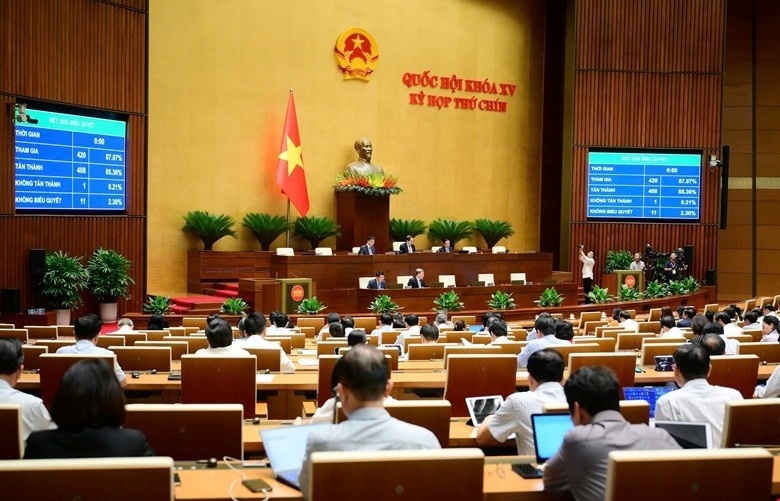Banks at the helm of Vietnam’s green finance push
Green loans are the most widely used green finance tool in Vietnam. As of late 2024, green loans accounted for nearly 4.5 per cent of total outstanding credit in Vietnam. Green bonds, with a value of $575 billion globally in 2023, are gaining popularity in Vietnam, with BIDV issuing the country’s first green bond backed by the World Bank in 2023, followed by HDBank’s issuance earlier this year, which raised $118 million.
 |
| (L-R) Jordan Lee, government advisory manager and Ly Nguyen, manager, come from Tony Blair Institute for Global Change |
Banks in Vietnam are also increasingly engaging in equity and investment fund structures through co-investments, fund sponsorship, and anchor investment in clean energy projects. For example, HSBC and the European Investment Bank pledged up to $12 billion to support Vietnam’s energy transition as a co-developer and anchor investor.
In addition, multilateral financial institutions such as the World Bank and the Private Infrastructure Development Group are increasingly employing credit guarantees to finance low-carbon infrastructure projects in Vietnam.
However, Vietnam aims to expand its renewable energy sector significantly in the coming years. Experts find that reaching energy sector targets will require $27.6 billion of investment annually from 2026-2030, nearly triple the country’s current annual energy investment. Therefore, it is crucial that Vietnam strengthen its green finance enabling environment to drive this investment.
One key initiative is for the government to develop a comprehensive regulatory framework, starting with finalisation of the green taxonomy and standardised guidelines to facilitate green finance instruments. The ASEAN Taxonomy, European Taxonomy, and national taxonomies in Indonesia, Malaysia, Singapore, and Thailand can be helpful references.
Finalising this is important, given the development of an international financial centre in Vietnam, which is expected to emphasise deployment of sustainable finance.
Establishing a green finance task force could help coordinate efforts to develop a green taxonomy to categorise certain economic activities as environmentally friendly and ideally drive investment towards these activities. Drawing on lessons from Singapore and Indonesia, this task force should be an inter-ministerial body, comprising representation from key authories, financial institutions, and other enablers of green finance.
A carbon market would also encourage increased green finance in Vietnam by enabling banks and other finance providers to monetise emissions reductions, guiding investment decisions and mobilising capital towards low-carbon solutions.
Vietnam is developing a carbon market, and it is vital that banks are involved in shaping its design to ensure the system provides useful investment signals. By putting a price on carbon, a transparent and robust market can improve project bankability and strengthen incentives for banks to fund low-carbon solutions.
With an enhanced enabling environment in place, state-owned and commercial banks will be better positioned to play a key role in the energy transition. Banks can expand the use of green lending and investment products such as sustainability-linked loans and bonds with explicit links to decarbonisation metrics.
Banks in Vietnam can help smaller green projects access new pools of financing through securitising green assets. Securitisation involves aggregating loans for small green projects into a single financial instrument that can be sold to institutional investors, who typically have minimum thresholds for investment.
By aggregating these, securitisation helps overcome scale and risk barriers, enabling capital to flow to smaller-scale green initiatives that might otherwise struggle to attract financing. Banks can also engage in stress testing and screening based on environmental, social, and governance (ESG) criteria to assess exposure to physical and transition risks.
Partnerships between domestic and international banks are also vital. These collaborations can support capacity-building in project appraisal, risk assessment, and monitoring. Multilateral development bank are well-positioned to help Vietnam’s banks through providing concessional loans, credit guarantees, and blended finance.
Reducing the cost of capital is particularly important in renewable energy, which typically involves higher upfront costs, but lower operating expenses compared to fossil fuel infrastructure, meaning that reducing the cost of capital has a large impact on overall bankability for renewables projects.
To unlock even more concessional capital, international and domestic banks in Vietnam can deepen their collaboration with philanthropies who can provide grant funding for the highest-impact but highest-risk elements of renewable energy deployment, such as feasibility studies for offshore wind.
While Vietnam’s banks are already taking meaningful steps to support the country’s energy transition, they will have to take additional measures to help the country reach its ambitious renewable energy targets. Through scaling-up sustainability-linked lending, ESG risk assessments, and efforts to leverage concessional capital, banks in Vietnam can help unlock the investment needed to accelerate a low-carbon transition.
 | Vietnam steps up green finance race with regional investments As Southeast Asia’s green economy accelerates, Vietnam is moving to catch up, backed by new legislation, rising investor focus, and a clearer national direction. |
What the stars mean:
★ Poor ★ ★ Promising ★★★ Good ★★★★ Very good ★★★★★ Exceptional
 Tag:
Tag:
Related Contents
Latest News
More News
- Pharmaceutical supply chains under threat of tariff changes (June 11, 2025 | 08:52)
- Strategic directions for science, tech, and the digital transition (June 10, 2025 | 10:43)
- Vietnamese banks are able to rise to the challenge (June 06, 2025 | 10:03)
- Private insurers must integrate advanced tactics (June 06, 2025 | 09:53)
- Real estate market can ride off back of resolution’s vision (June 04, 2025 | 10:06)
- Updates to clarify state capital funding rules (May 30, 2025 | 10:50)
- Private entities urged to play more crucial role (May 30, 2025 | 10:00)
- What is the correct answer to tackle counterfeit drug sales? (May 30, 2025 | 08:53)
- Private sector policy shifts can mean a market lift (May 28, 2025 | 15:37)
- Legislatory shift can support recovery of bad debts (May 28, 2025 | 14:56)


















 Mobile Version
Mobile Version